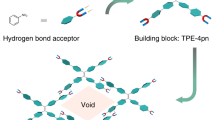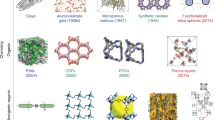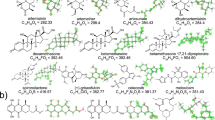Abstract
The field of host–guest complexation is intensely attractive from diverse perspectives, including materials science, chemistry and biology. The uptake and encapsulation of guest species by host frameworks are being investigated for a wide variety of purposes, including separation and storage using zeolites, and recognition and sensing by enzymes in solution. Here we focus on the concept of the cooperative integration of 'softness' and 'regularity'. Recent developments on porous coordination polymers (or metal–organic frameworks) have provided the inherent properties that combine these features. Such soft porous crystals exhibit dynamic frameworks that are able to respond to external stimuli such as light, electric fields or the presence of particular species, but they are also crystalline and can change their channels reversibly while retaining high regularity. We discuss the relationship between the structures and properties of these materials in view of their practical applications.
This is a preview of subscription content, access via your institution
Access options
Subscribe to this journal
Receive 12 print issues and online access
$259.00 per year
only $21.58 per issue
Buy this article
- Purchase on Springer Link
- Instant access to full article PDF
Prices may be subject to local taxes which are calculated during checkout







Similar content being viewed by others
References
Yaghi, O. M., Li, H. L., Davis, C., Richardson, D. & Groy, T. L. Synthetic strategies, structure patterns, and emerging properties in the chemistry of modular porous solids. Acc. Chem. Res. 31, 474–484 (1998).
Kitagawa, S. & Kondo, M. Functional micropore chemistry of crystalline metal complex-assembled compounds. Bull. Chem. Soc. Jpn 71, 1739–1753 (1998).
Blake, A. J. et al. Inorganic crystal engineering using self-assembly of tailored building-blocks. Coord. Chem. Rev. 183, 117–138 (1999).
Moulton, B. & Zaworotko, M. J. From molecules to crystal engineering: Supramolecular isomerism and polymorphism in network solids. Chem. Rev. 101, 1629–1658 (2001).
James, S. L. Metal-organic frameworks. Chem. Soc. Rev. 32, 276–288 (2003).
Janiak, C. Engineering coordination polymers towards applications. Dalton Trans. 2781–2804 (2003).
Papaefstathiou, G. S. & MacGillivray, L. R. Inverted metal-organic frameworks: solid-state hosts with modular functionality. Coord. Chem. Rev. 246, 169–184 (2003).
Côté, A. P. & Shimizu, G. K. H. The supramolecular chemistry of the sulfonate group in extended solids. Coord. Chem. Rev. 245, 49–64 (2003).
Kitagawa, S., Kitaura, R. & Noro, S. Functional porous coordination polymers. Angew. Chem. Int. Ed. 43, 2334–2375 (2004).
Rao, C. N. R., Natarajan, S. & Vaidhyanathan, R. Metal carboxylates with open architectures. Angew. Chem. Int. Ed. 43, 1466–1496 (2004).
Bradshaw, D., Claridge, J. B., Cussen, E. J., Prior, T. J. & Rosseinsky, M. J. Design, chirality, and flexibility in nanoporous molecule-based materials. Acc. Chem. Res. 38, 273–282 (2005).
Müller, U. et al. Metal-organic frameworks - prospective industrial applications. J. Mater. Chem. 16, 626–636 (2006).
Maspoch, D., Ruiz-Molina, D. & Veciana, J. Old materials with new tricks: multifunctional open-framework materials. Chem. Soc. Rev. 36, 770–818 (2007).
Férey, G. Hybrid porous solids: past, present, future. Chem. Soc. Rev. 37, 191–214 (2008).
Morris, R. E. & Wheatley, P. S. Gas storage in nanoporous materials. Angew. Chem. Int. Ed. 47, 4966–4981 (2008).
Allendorf, M. D., Bauer, C. A., Bhakta, R. K. & Houk, R. J. T. Luminescent metal-organic frameworks. Chem. Soc. Rev. 38, 1330–1352 (2009).
Tanaka, T., Tasaki, T. & Aoyama, Y. Acridinylresorcinol as a self-complementary building block of robust hydrogen-bonded 2D nets with coordinative saturation. Preservation of crystal structures upon guest alteration, guest removal, and host modification. J. Am. Chem. Soc. 124, 12453–12462 (2002).
Atwood, J. L., Barbour, L. J. & Jerga, A. Storage of methane and freon by interstitial van der Waals confinement. Science 296, 2367–2369 (2002).
Soldatov, D. V. et al. alpha- and beta-bis(1, 1, 1-trifluoro-5,5-dimethyl-5-methoxyacetylacetonato)copper(II): Transforming the dense polymorph into a versatile new microporous framework. J. Am. Chem. Soc. 121, 4179–4188 (1999).
Alberti, G., Murcia-Mascaros, S. & Vivani, R. Pillared derivatives of gamma-zirconium phosphate containing nonrigid alkyl chain pillars. J. Am. Chem. Soc. 120, 9291–9295 (1998).
Clearfield, A. & Wang, Z. K. Organically pillared microporous zirconium phosphonates. Dalton Trans. 2937–2947 (2002).
Lee, Y. et al. Phase transition of zeolite RHO at high-pressure. J. Am. Chem. Soc. 123, 8418–8419 (2001).
Fletcher, A. J., Thomas, K. M. & Rosseinsky, M. J. Flexibility in metal-organic framework materials: Impact on sorption properties. J. Solid State Chem. 178, 2491–2510 (2005).
Uemura, K., Matsuda, R. & Kitagawa, S. Flexible microporous coordination polymers. J. Solid State Chem. 178, 2420–2429 (2005).
Sing, K. S. W. et al. reporting physisorption data for gas solid systems with special reference to the determination of surface-area and porosity (recommendations 1984). Pure Appl. Chem. 57, 603–619 (1985).
Batten, S. R. & Robson, R. Interpenetrating nets: Ordered, periodic entanglement. Angew. Chem. Int. Ed. 37, 1460–1494 (1998).
Li, D. & Kaneko, K. Hydrogen bond-regulated microporous nature of copper complex-assembled microcrystals. Chem. Phys. Lett. 335, 50–56 (2001).
Kitaura, R., Seki, K., Akiyama, G. & Kitagawa, S. Porous coordination-polymer crystals with gated channels specific for supercritical gases. Angew. Chem. Int. Ed. 42, 428–430 (2003).
Coudert, F. X., Jeffroy, M., Fuchs, A. H., Boutin, A. & Mellot-Draznieks, C. Thermodynamics of guest-induced structural transitions in hybrid organic-inorganic frameworks. J. Am. Chem. Soc. 130, 14294–14302 (2008).
Horike, S., Tanaka, D., Nakagawa, K. & Kitagawa, S. Selective guest sorption in an interdigitated porous framework with hydrophobic pore surfaces. Chem. Commun. 3395–3397 (2007).
Tanaka, D. et al. Kinetic gate-opening process in a flexible porous coordination polymer. Angew. Chem. Int. Ed. 47, 3914–3918 (2008).
Chen, B. L. et al. A microporous metal-organic framework for gas-chromatographic separation of alkanes. Angew. Chem. Int. Ed. 45, 1390–1393 (2006).
Maji, T. K., Matsuda, R. & Kitagawa, S. A flexible interpenetrating coordination framework with a bimodal porous functionality. Nature Mater. 6, 142–148 (2007).
Amirjalayer, S., Tafipolsky, M. & Schmid, R. Molecular dynamics simulation of benzene diffusion in MOF-5: Importance of lattice dynamics. Angew. Chem. Int. Ed. 46, 463–466 (2007).
Han, S. S., Deng, W. Q. & Goddard, W. A. Improved designs of metal-organic frameworks for hydrogen storage. Angew. Chem. Int. Ed. 46, 6289–6292 (2007).
Ryan, P., Broadbelt, L. J. & Snurr, R. Q. Is catenation beneficial for hydrogen storage in metal-organic frameworks? Chem. Commun. 4132–4134 (2008).
Watanabe, S., Sugiyama, H., Adachi, H., Tanaka, H. & Miyahara, T. M. Free energy analysis for adsorption-induced lattice transition of flexible coordination framework. J. Chem. Phys. 130, 164707 (2009).
Seki, K. Dynamic channels of a porous coordination polymer responding to external stimuli. Phys. Chem. Chem. Phys. 4, 1968–1971 (2002).
Biradha, K. & Fujita, M. A springlike 3D-coordination network that shrinks or swells in a crystal-to-crystal manner upon guest removal or readsorption. Angew. Chem. Int. Ed. 41, 3392–3395 (2002).
Mulfort, K. L. & Hupp, J. T. Chemical reduction of metal-organic framework materials as a method to enhance gas uptake and binding. J. Am. Chem. Soc. 129, 9604–9605 (2007).
Atkins, P., Overton, T., Rourke, J. & Weller, M. Inorganic Chemistry 4th edn (Oxford Univ. Press, 2006).
Serre, C. et al. Very large breathing effect in the first nanoporous chromium(III)-based solids: MIL-53 or CrIII(OH){O2C-C6H4-CO2}{HO2C-C6H4 -CO2H}x⋅H2Oy . J. Am. Chem. Soc. 124, 13519–13526 (2002).
Llewellyn, P. L., Bourrelly, S., Serre, C., Filinchuk, Y. & Férey, G. How hydration drastically improves adsorption selectivity for CO2 over CH4 in the flexible chromium terephthalate MIL-53. Angew. Chem. Int. Ed. 45, 7751–7754 (2006).
Alaerts, L. et al. Selective adsorption and separation of xylene isomers and ethylbenzene with the microporous vanadium(IV) terephthalate MIL-47. Angew. Chem. Int. Ed. 46, 4293–4297 (2007).
Horcajada, P. et al. Flexible porous metal-organic frameworks for a controlled drug delivery. J. Am. Chem. Soc. 130, 6774–6780 (2008).
Choi, H., Dincă, M. & Long, J. R. Broadly hysteretic H2 adsorption in the microporous metal-organic framework Co(1,4-benzenedipyrazolate). J. Am. Chem. Soc. 130, 7848–7850 (2008).
Matsuda, R. et al. Guest shape-responsive fitting of porous coordination polymer with shrinkable framework. J. Am. Chem. Soc. 126, 14063–14070 (2004).
Yang, S. H. et al. Cation-induced kinetic trapping and enhanced hydrogen adsorption in a modulated anionic metal-organic framework. Nature Chem. 1, 487–493 (2009).
Telfer, S. G., Sato, T., Kuroda, R., Lefebvre, J. & Leznoff, D. B. Dinuclear complexes of chiral tetradentate pyridylimine ligands: Diastereoselectivity, positive cooperativity, anion selectivity, ligand self-sorting based on chirality, and magnetism. Inorg. Chem. 43, 421–429 (2004).
Uemura, T. et al. Conformation and molecular dynamics of single polystyrene chain confined in coordination nanospace. J. Am. Chem. Soc. 130, 6781–6788 (2008).
Gonzalez, J., Devi, R. N., Tunstall, D. P., Cox, P. A. & Wright, P. A. Deuterium NMR studies of framework and guest mobility in the metal-organic framework compound MOF-5, Zn4O(O2CC6H4CO2)3 . Micropor. Mesopor. Mater. 84, 97–104 (2005).
Horike, S. et al. Dynamic motion of building blocks in porous coordination polymers. Angew. Chem. Int. Ed. 45, 7226–7230 (2006).
Gould, S. L., Tranchemontagne, D., Yaghi, O. M. & Garcia-Garibay, M. A. Amphidynamic character of crystalline MOF-5: Rotational dynamics of terephthalate phenylenes in a free-volume, sterically unhindered environment. J. Am. Chem. Soc. 130, 3246–3247 (2008).
Winston, E. B. et al. Dipolar molecular rotors in the metal-organic framework crystal IRMOF-2. Phys. Chem. Chem. Phys. 10, 5188–5191 (2008).
Zhang, J. P. & Chen, X. M. Exceptional framework flexibility and sorption behavior of a multifunctional porous cuprous triazolate framework. J. Am. Chem. Soc. 130, 6010–6017 (2008).
Tafipolsky, M., Amirjalayer, S. & Schmid, R. Ab initio parametrized MM3 force field for the metal-organic framework MOF-5. J. Comput. Chem. 28, 1169–1176 (2007).
Dybtsev, D. N., Chun, H. & Kim, K. Rigid and flexible: A highly porous metal-organic framework with unusual guest-dependent dynamic behavior. Angew. Chem. Int. Ed. 43, 5033–5036 (2004).
Uemura, T., Hiramatsu, D., Kubota, Y., Takata, M. & Kitagawa, S. Topotactic linear radical polymerization of divinylbenzenes in porous coordination polymers. Angew. Chem. Int. Ed. 46, 4987–4990 (2007).
Choi, H. J. & Suh, M. P. Dynamic and redox active pillared bilayer open framework: Single-crystal-to-single-crystal transformations upon guest removal, guest exchange, and framework oxidation. J. Am. Chem. Soc. 126, 15844–15851 (2004).
Suh, M. P., Moon, H. R., Lee, E. Y. & Jang, S. Y. A redox-active two-dimensional coordination polymer: Preparation of silver and gold nanoparticles and crystal dynamics on guest removal. J. Am. Chem. Soc. 128, 4710–4718 (2006).
Shimomura, S., Matsuda, R., Tsujino, T., Kawamura, T. & Kitagawa, S. TCNQ dianion-based coordination polymer whose open framework shows charge-transfer type guest inclusion. J. Am. Chem. Soc. 128, 16416–16417 (2006).
Férey, G. et al. Mixed-valence Li/Fe-based metal-organic frameworks with both reversible redox and sorption properties. Angew. Chem. Int. Ed. 46, 3259–3263 (2007).
Combelles, C. & Doublet, M. L. Structural, magnetic and redox properties of a new cathode material for Li-ion batteries: the iron-based metal organic framework. Ionics 14, 279–283 (2008).
Lu, Y. et al. A cobalt(II)-containing metal-organic framework showing catalytic activity in oxidation reactions. Z. Anorg. Allg. Chem. 634, 2411–2417 (2008).
Ohba, M., Yamada, M., Usuki, N. & Okawa, H. New 3-D bimetallic magnetic compounds, [Ni(dipn)]3[M(CN)6]2⋅7H2O (M-III=Fe, Co; dipn=N, N-di(3-aminopropyl)amine). Mol. Cryst. Liq. Cryst. 379, 241–246 (2002).
Yanai, N. et al. fabrication of two-dimensional polymer arrays: template synthesis of polypyrrole between redox-active coordination nanoslits. Angew. Chem. Int. Ed. 47, 9883–9886 (2008).
Halder, G. J., Kepert, C. J., Moubaraki, B., Murray, K. S. & Cashion, J. D. Guest-dependent spin crossover in a nanoporous molecular framework material. Science 298, 1762–1765 (2002).
Maspoch, D. et al. A nanoporous molecular magnet with reversible solvent-induced mechanical and magnetic properties. Nature Mater. 2, 190–195 (2003).
Kurmoo, M., Kumagai, H., Hughes, S. M. & Kepert, C. J. Reversible guest exchange and ferrimagnetism (TC = 60.5 K) in a porous cobalt(II)-hydroxide layer structure pillared with trans-1, 4-cyclohexanedicarboxylate. Inorg. Chem. 42, 6709–6722 (2003).
Cheng, X. N., Zhang, W. X. & Chen, X. M. Single crystal-to-single crystal transformation from ferromagnetic discrete molecules to a spin-canting antiferromagnetic layer. J. Am. Chem. Soc. 129, 15738–15739 (2007).
Niel, V., Martinez-Agudo, J. M., Munoz, M. C., Gaspar, A. B. & Real, J. A. Cooperative spin crossover behavior in cyanide-bridged Fe(II)-M(II) bimetallic 3D Hofmann-like networks (M = Ni, Pd, and Pt). Inorg. Chem. 40, 3838–3839 (2001).
Ohba, M. et al. Bidirectional chemo-switching of spin state in a microporous framework. Angew. Chem. Int. Ed. 48, 4767–4771 (2009).
Southon, P. D. et al. Dynamic interplay between spin-crossover and host-guest function in a nanoporous metal-organic framework material. J. Am. Chem. Soc. 131, 10998–11009 (2009).
Cobo, S. et al. Single-laser-shot-induced complete bidirectional spin transition at room temperature in single crystals of (Fe-II(pyrazine)(Pt(CN)4)). J. Am. Chem. Soc. 130, 9019–9024 (2008).
McKinlay, A. C. et al. Exceptional behavior over the whole adsorption-storage-delivery cycle for NO in porous metal organic frameworks. J. Am. Chem. Soc. 130, 10440–10444 (2008).
Kubota, Y. et al. Metastable sorption state of a metal-organic porous material determined by in situ synchrotron powder diffraction. Angew. Chem. Int. Ed. 45, 4932–4936 (2006).
Jain, P., Dalal, N. S., Toby, B. H., Kroto, H. W. & Cheetham, A. K. Order-disorder antiferroelectric phase transition in a hybrid inorganic-organic framework with the perovskite architecture. J. Am. Chem. Soc. 130, 10450–10451 (2008).
Wang, Z. Q. & Cohen, S. M. Tandem modification of metal-organic frameworks by a postsynthetic approach. Angew. Chem. Int. Ed. 47, 4699–4702 (2008).
Kitagawa, S. Gas in a straitjacket. Nature 441, 584–585 (2006).
Stallmach, F. et al. NMR studies on the diffusion of hydrocarbons on the metal-organic framework material MOF-5. Angew. Chem. Int. Ed. 45, 2123–2126 (2006).
Huang, B. L. et al. Thermal conductivity of a metal-organic framework (MOF-5): Part II. Measurement. Int. J. Heat Mass Transfer 50, 405–411 (2007).
Navarro, J. A. R. et al. Guest-induced modification of a magnetically active ultramicroporous, gismondine-like, copper(II) coordination network. J. Am. Chem. Soc. 130, 3978–3984 (2008).
Shimomura, S., Horike, S., Matsuda, R. & Kitagawa, S. Guest-specific function of a flexible undulating channel in a 7, 7, 8, 8-tetracyano-p-quinodimethane dimer-based porous coordination polymer. J. Am. Chem. Soc. 129, 10990–10991 (2007).
Cho, W., Lee, H. J. & Oh, M. Growth-controlled formation of porous coordination polymer particles. J. Am. Chem. Soc. 130, 16943–16946 (2008).
Tsuruoka, T. et al. Nanoporous nanorods fabricated by coordination modulation and oriented attachment growth. Angew. Chem. Int. Ed. 48, 4739–4743 (2009).
Lin, W. B., Rieter, W. J. & Taylor, K. M. L. Modular synthesis of functional nanoscale coordination polymers. Angew. Chem. Int. Ed. 48, 650–658 (2009).
Shekhah, C. et al. Step-by-step route for the synthesis of metal-organic frameworks. J. Am. Chem. Soc. 129, 15118–15119 (2007).
Scherb, C., Schödel, A. & Bein, T. Directing the structure of metal-organic frameworks by oriented surface growth on an organic monolayer. Angew. Chem. Int. Ed. 47, 5777–5779 (2008).
Yoo, Y. & Jeong, H. K. Rapid fabrication of metal organic framework thin films using microwave-induced thermal deposition. Chem. Commun. 2441–2443 (2008).
Furukawa, S. et al. Heterogeneously hybridized porous coordination polymer crystals: fabrication of heterometallic core–shell single crystals with an in-plane rotational epitaxial relationship. Angew. Chem. Int. Ed. 48, 1766–1770 (2008).
Acknowledgements
This work was financially supported by Japan Science and Technology Agency (JST), ERATO Kitagawa Integrated Pores Project.
Author information
Authors and Affiliations
Corresponding author
Rights and permissions
About this article
Cite this article
Horike, S., Shimomura, S. & Kitagawa, S. Soft porous crystals. Nature Chem 1, 695–704 (2009). https://doi.org/10.1038/nchem.444
Published:
Issue Date:
DOI: https://doi.org/10.1038/nchem.444
This article is cited by
-
Progress toward the computational discovery of new metal–organic framework adsorbents for energy applications
Nature Energy (2024)
-
Diffusion-rate sieving of propylene and propane mixtures in a cooperatively dynamic porous crystal
Nature Communications (2024)
-
Selective sorting of hexane isomers by anion-functionalized metal-organic frameworks with optimal energy regulation
Nature Communications (2024)
-
Switching molecular recognition selectivities by temperature in a diffusion-regulatory porous material
Nature Communications (2024)
-
Effector-dependent structural transformation of a crystalline framework with allosteric effects on molecular recognition ability
Nature Communications (2023)



